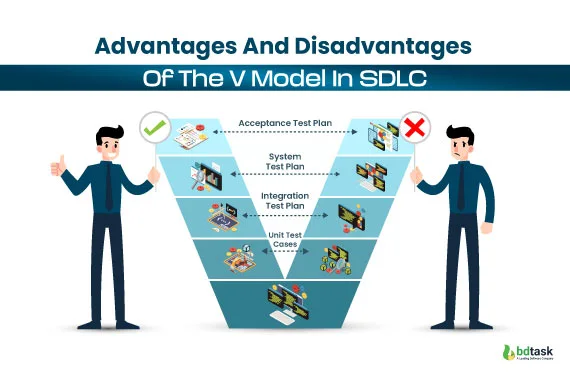V Model In Software Development - Best Practice in SDLC Process
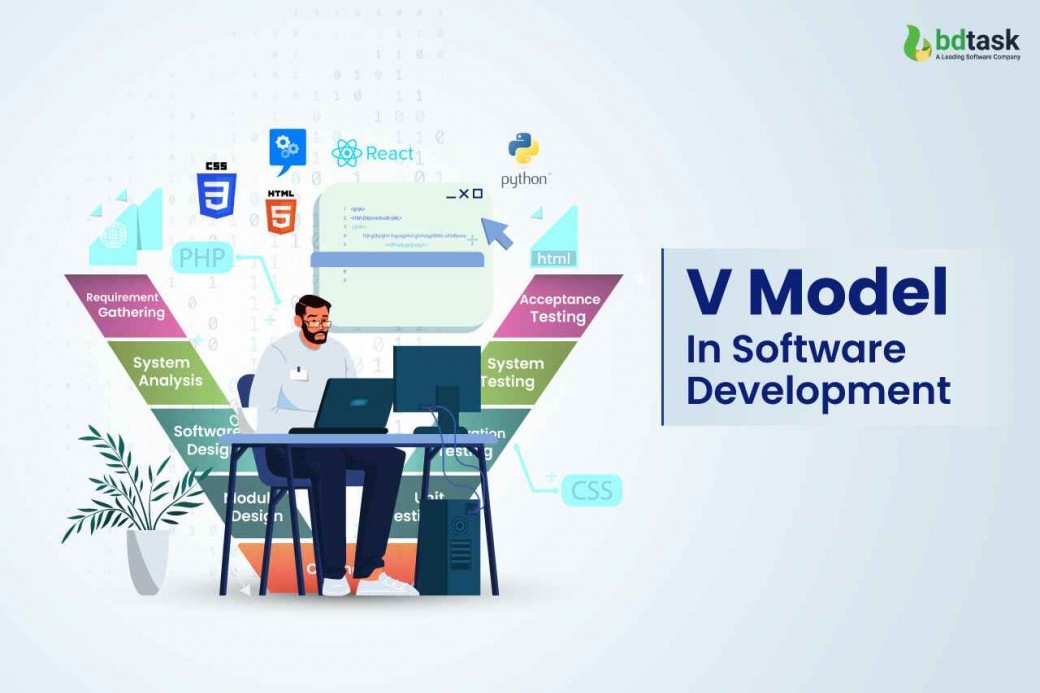
V model in software development is a classified part of a software development life cycle (SDLC), which carry out linearly and sequentially in the V model. The V model in software development is also called the verification and validation model (V&V model).
The V model in the software development life cycle is considered an extension of the waterfall model, which means the V model development follows the same method the waterfall method uses in the software development life cycle process but with a simple twist.
While using the V software development model, every individual development lifecycle (verification phrase) must be passed through the testing lifecycle (validation phrase). The v model of software development is a high-level discipline model, which means developers cannot go to the next phase until the completion of the previous phase.
This article develops a complete guideline on the V-model of the software development lifecycle.
What is V Model in Software Development?
Definition & Diagram Of V Model In SDLC
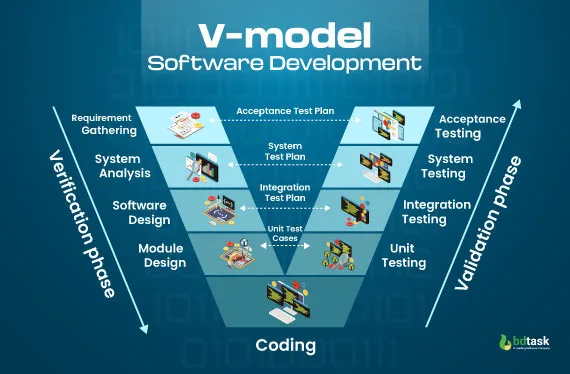
This V Model is named after the v model in the SDLC process. The V-shape model in software development provides a systematic and graphical representation path.
V-model in software development is inspired by the shape “V”, the two legs.
The two legs of “V” in the V-shape model represent the revolution process in SDLC.
The left side of the “V” represents the verification phase, and the right side of the “V” represents the validation phase.
And both the legs (verification and validation phase) connect in the “Coding Phase”, which is at the base of the V shape.
The left side in the V model (verification phase) shows the software developer’s life cycle progression. Therefore while handling a software project, a developer follows V model steps such as understanding the client business requirement specification, creating a system design plan, architecture software design, module design, and coding phrase.
And on the right side in the V model (validation phase) shows the software tester’s life cycle progression. Therefore while handling a software project, a quality assurance or software tester will follow a V-shape model sequence such as user-acceptance testing, system testing, integration testing and unit testing.
Lastly, the V model software development base is the “Coding phrase”, where the two legs of the V model are joined together. This phase of the v model of software development is also called the implementation phase.
In this phase of the v model, the developer will choose a programming language based on the product and architecture requirements. The coding of the software project will be performed by maintaining coding guidelines and standards and will go through different code reviews to check its performance.
Diagram of V Model
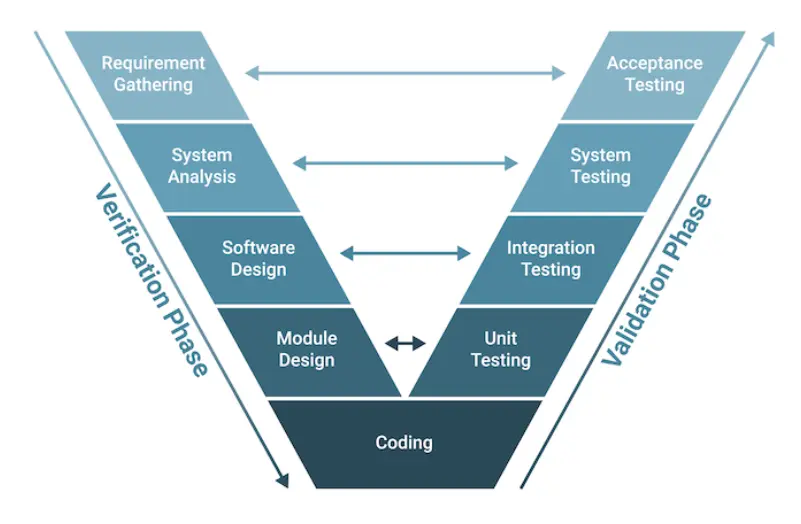
How Does V Shape Model Work
How work V shape model and when to use this model in software development life cycle?
Since you’ve come to this point of the blog, I think you’ve gathered minimum basic information about the V-model of software development.
In this part, you’re going to educate about the implementation process of the V model while developing a software project and also when to use the V model in the software development life cycle.
Working Process Of V Shape Model In SDLC Roadmap
While designing any complex automotive or application software, every developer looks for flexibility, speed and the skills to improve the code.
The working process of the V model begins upper left (verification phase) by requirement gathering, continuous down, joined to the implementation or coding phase (base part of V-model) and ends at the final testing of the upper right end.
Below, you’ll find the elements of the working process of the V model:
- System Requirements: In this element of the V Model, engineers will gather both the business and system requirements. And it’s important to clear out the outcomes the automotive function or features will achieve.
- System Design: In this part of the V model, engineers will design the functionality of the project with the help of a model-based development environment. Through this process, developers can test the model and find errors/bugs early in the process.
- Software Requirements:
In this stage, an engineer will use system requirements, and the resulting system design will define the achievement of the software to fulfill the needs.
- Software Implementation:
In this phase of the V-shape model, engineers will generate and compile the code needed to construct the software. All the code written for the software will go through a testing phase to confirm the requirements asked for the software (verification phase) and ensure the outcome is suitable for the application (validation phase).
- Software Integration and Qualification Testing:
Software implementation is usually applied on a per-features or per-software component scale. To get a complete software development solution, every smaller-scale implementation is integrated with a single compiled whole, tested in every entity.
- System Integration and Qualification Testing
In this stage of the V model, all the software and hardware will be assembled into a whole system for testing. And the quality assurance officer uses software in the loop, hardware in the loop and vehicle in the loop to test the software.
When To Use V Model In Software Development Life Cycle?
In the whole SDLC process, there is a time when developers have to decide which model to use in their software project. There is some fixed situation and logic when to use the V model in software development, and they are:
- When the software project’s requirement is clear and fixed
- When ample technical resources are available with different technical expertise
- Small, medium size software development projects with clearly defined needs
- It’s better not to use the V Model in large projects because it’s challenging to keep sticking to one plan.
Principle Of V-Model Of Software Development
The V-Model, also called the Validation and Verification Model, is a software development and testing methodology emphasising the relationship between each development phase and its corresponding testing phase. Here are the key principles of the V-Model:
Large To Small Project:
Systematically, the v model follows a hierarchical perspective. For instance, after the team gathers the requirements, as the v model suggests, they’ll create a high-level design, low-level design and then code; each level should be completed before going to the next.
Data/ Process Integrity:
The team will require the incorporation and cohesion of data and processes to make a software development project successful.
Scalability:
V model is suitable for any IT project irrespective of size, complexity and duration.
Cross Referencing
A correlation between requirement gathering and corresponding testing activities.
Tangible Document
Creating a tangible document of a software project is mandatory because well-documented can be helpful material for both the project development and support teams.
Verification Phase Of V Model In Software Development
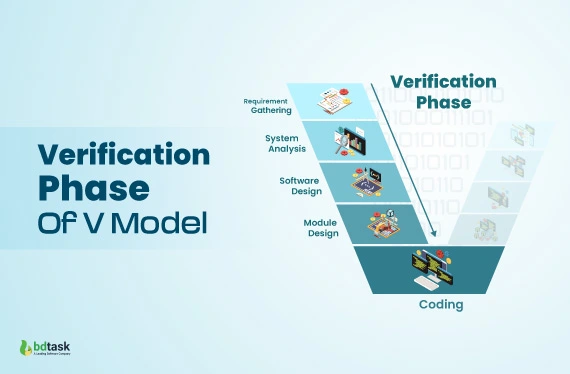
The verification phase of the v model in software development follows a static analysis with code execution. This phase of the v model is like an evaluation model, conducted during the development process so that developers can verify whether all the requirements are covered.
Business Requirement Specification
Requirement collection from the client is the first phase of SDLC, where developers keep an open mind to hear, understand and try to picture the solution from the client's perspective.
The session with the client will be a direct detailed conversation so that a software engineer can understand this project's exact requirements and expectations.
System Requirement Specification
This part of SDLC starts soon after the developer finishes gathering requirements and designing the application system. The system design will be developed based on the understanding and requirements of the clients, hardware, and communication setup for the software project. Moreover, a system test plan will also be developed based on the system design.
Architecture Or High-Level Design
This phase of the v model in software development is also called high-level design and is only for designing the architecture of software projects. Even though one technical approach is proposed, the final decision will only be taken depending on the technical and financial feasibility.
Module Design Or Low-Level Design
This phase is about working on the internal design, such as parental modules, sub-modules and software features. While developing software, a developer needs to remember that the internal design should be compatible with modules of the system architecture and other external systems.
Another part of this phase is unit testing, which is an essential part of the development phase because it assists in eliminating the maximum number of bugs in the early stage of development.
Implementation Phrase Or Coding Phrase
This phase of the v model is dedicated to coding the system module. The developer will choose the best suitable programming language depending on the system and architectural requirements.
To generate code, developers will follow the general coding guideline and standards. Whatever the developer's code, the code will go through numerous code reviews and code optimization for better performance.
Validation Phase Of V Model In Software Development
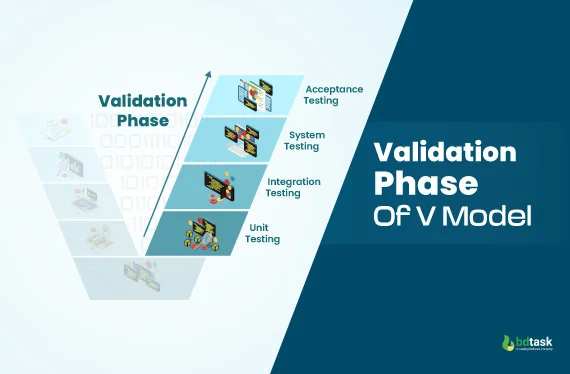
The validation phase of the V Model in software testing follows the dynamic analysis method. This phase is to run tests to ensure that the developed software application matches the client's requirements.
User-Acceptance Testing
User acceptance testing is directly linked with the verification phase's business requirement analysis. At this stage the developer will test the product in the user environment and uncover all the compatibility issues with other systems. This user acceptance testing also explores all the non-functional issues, for instance, loading and performance detectors in the user environment.
System Testing
System testing in the validation phase is directly linked with the system design phase. In this stage, the developer will run a system test, check the entire system functionality, and communicate with the external system. However, developers can discover different software and hardware compatibility issues through system testing.
Integration Testing
Integration testing in the validation phase is directly linked with the architecture design phase. Developers run integrating testing to identify the coexistence and communication of the internal module in the system.
Unit Testing
Unit testing in the validation phase is specifically designed to test module codes in the system. Usually, unit testing runs to test the code level and eliminate the bugs, errors etc.
Advantages And Disadvantages Of The V Model In SDLC
Each stage of the V Model is associated with a corresponding testing phase, forming a "V" shape when represented graphically. Here are some disadvantages and advantages of V Model in SDLC:
Advantage Of The V Model In SDLC
- It provides a well-defined path for development and testing activities and makes the software project easier to plan and predict project timelines and outcomes.
- Promotes a structured and systematic approach to software development. To avoid overlooking the project's crucial aspects, each stage must be completed before moving to the next stage.
- Testing is integrated from the early stages of development, ensuring defects are identified and addressed early.
- Because of its structured nature, the V Model requires comprehensive documentation of every stage. Hence, it can be beneficial for maintaining the software and facilitating future enhancements.
- V model encourages a good collaboration between the development terms, therefore can reduce ambiguity and create a clear understanding among the team.
Disadvantage Of V Model In Software Development Life Cycle
- The V Model's strict sequential approach can make it inflexible when changes are required. If a change is needed after a particular stage has been completed, it might necessitate revisiting earlier stages, increasing time and effort.
- User feedback and involvement are typically limited until the testing phases, which can lead to the possibility of the final product not meeting user expectations or needs.
- Fixing defects or making changes later in the development process can be expensive, as they may require adjustments in multiple stages and testing activities.
- The sequential nature of the V Model can lead to longer project timelines, especially for larger projects, as each stage needs to be completed before moving on to the next.
- The V Model is less adaptive to changing requirements or market conditions than more agile methodologies. This can be a disadvantage in fast-paced and dynamic environments.
- Managing dependencies between stages and ensuring proper development and testing activities synchronization can be complex and challenging.
Other SDLC Model Developer Can Use To Develop Their Project:
- Waterfall model
- Incremental model
- RAD model
- Agile model
- Iterative model
- Spiral model
- Prototype model
Conclusion
The V-Model in software development offers a structured and systematic approach to software development and testing, emphasizing the close relationship between development phases and their corresponding testing phases.
By aligning testing activities with each stage of development, the V-Model aims to ensure the delivery of high-quality software that meets user requirements and expectations.
